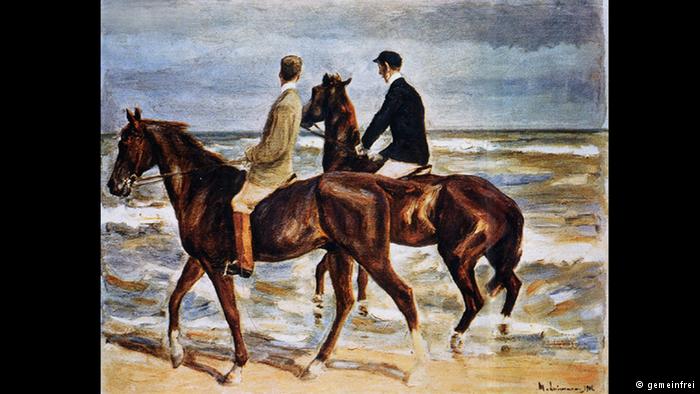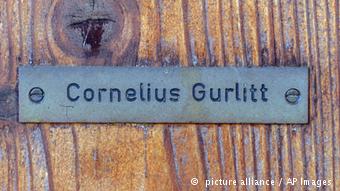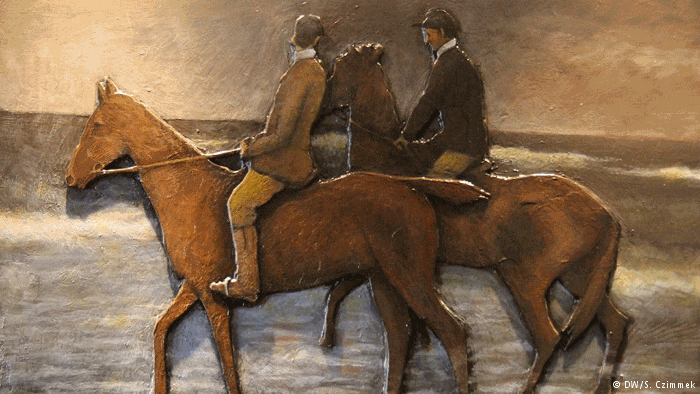News:
Nazi-looted Liebermann painting goes under the hammer
By Stefan Dege
Historically speaking, it's practically invaluable. Once stolen by the Nazis, then found in the famous Gurlitt collection, Max Liebermann's "Two Riders" is up for auction at Sotheby's. Will it sell - and should it?

Two riders atop lean, brown horses stroll along the edge of the water. The men are wearing riding boots, caps and jackets. The waves are gentle, but the power of the ocean behind them is evident.
Max Liebermann (1847-1935) put many such scenes on canvas. The Impressionist was often drawn to the coast of Holland, where he found inspiration in the light, the people and the landscape. Liebermann was co-founder and chairman of the Berlin Secession art association and president of the Prussian Academy of the Arts. He suffered under the Nazis - but could never have imagined the extent to which his "Two Riders on the Beach" would be trampled on, both politically and legally.
It was the art sensation of the century when the work turned up in 2012 in the Munich apartment of collector Cornelius Gurlitt, along with hundreds of others, many of which were suspected of being looted by the Nazis decades before. The Bavarian authorities secured the works and the state quickly put together a team of provenience researchers to look into the origin of each artwork.
In 2014, the researchers came to the conclusion that it is "very probable" that Liebermann's painting had been unethically or illegally acquired by the Nazis. It was then returned to its earlier owner and landed on the market four weeks later. Now it's expected to fetch at least 480,000 euros (over half a million dollars) at Sotheby's in London on Wednesday (24.06.2015).
Passed through many hands
As early as 1954, nine years after the end of the war, "Two Riders" was displayed in a Liebermann restropective in the Kunsthalle Bremen. In 1960, it went on show in exhibitions in Berlin, Recklinghausen and Vienna.
"No one made the accusation at the time that it could be a piece of Nazi-looted art," pointed out the German daily "Frankfurter Allgemeine Zeitung."
Those who review Liebermann's catalogue of works will find that the original owner of the painting was David Friedmann, a Jewish brick maker and art collector in Breslau, which is now the Polish city of Wroclaw. He owned the painting at least until 1928, according to the records.
"In 1938 at the latest, David Friedmann's family was persecuted by the Nazis," wrote the provenience research team, known as the Taskforce Schwabinger Kunstfund.
Evidence of what happened next can be found in a letter from high-raking Breslau official Dr. Ernst Westram to the finance minister of Nazi Germany, Walther Funk, on December 5, 1939, in which Westram inquired how he could "legally" relieve Jews of their valuable artworks. An official appraisal of David Friedmann's collection, which included "The Two Riders," seemed to Westram to be too low.
He considered the "Riders" to be worth 15 times as much as the estimate. The Nazis forbid Friedmann from selling his collection. Three years later, he passed away of natural causes. The rest of his family was murdered during the Holocaust.
The director of the Silesian Museum of Fine Arts in Breslau, Conrad Müller Hofstede, bought the painting at an auction for 1,600 Reichsmark, though the date of the transaction remains unknown. In 1942, he sold the "Riders" to Cornelius Gurlitt's father, Hildebrand Gurlitt, who was known by some as "Adolf Hitler's art dealer."
After World War II, the so-called Monuments Men - Allied experts tasked with recovering artworks - took possession of the work. But it was returned to Gurlitt in 1950 due to a lack of documentation on its provenience. Gurlitt claimed to have owned the work already in 1933.
In this way, many pieces of art found their way back into the hands of Cornelius Gurlitt after the war. He died in May 2014 and bequeathed his collection to the Kunstmuseum in Bern, Switzerland.
Painting returned to rightful heirs
It was New York-based attorney David Toren who put the "Riders" up for auction in London. Memories of the Liebermann painting have accompanied Toren, now 89, his whole life. David Friedmann was his great-uncle, and the work hung in Friedmann's villa.
"I saw the painting for the last time the day after the Crystal Night on November 9, 1938," Toren told DW in a 2014 interview, referring to the horrific Jewish pogrom. "My father had been arrested in the morning by the Gestapo. The day after the Crystal Night, all Jewish men in Germany of the age of 17 to 75, including my father, were sent to the Buchenwald concentration camp for three weeks as punishment."
Toren was 14 years old at the time and was left sitting in the room where the Liebermann was hanging. "I looked at it for hours, because I had to wait. I always liked that painting because I like horses," he said.
David Toren sued Germany and the state of Bavaria for the return of the work, though he did not demand financial compensation. The sentimental value of the work is much greater for him. "The painting is an heirloom," he told DW in 2014. "It belongs to my family. No one else should have it. It could be one of the few things which could remind me of my background, of my family."
Now, it seems, he's changed his mind. "I am 90 years old now and blind so, while the return of the paintings after so many years is of huge personal significance, I can no longer appreciate the painting as I did all those years ago," said Toren recently.
Too pricy for a German museum
The work which is going under the hammer at Sotheby's is just one of Liebermann's rider paintings. A nearly identical piece, which contains one horse leg fewer, is owned by Dusseldorf art dealer Rainer M. Ludorff. While he is following the London auction carefully, he won't be bidding. Ludorff says the estimated price of 480,000 euros is "unrealistic." Instead, it will fetch 1.2-1.5 million euros, he predicts - three times the estimated price and "too much for any German museum."
Martin Faass, director of a small collection of garden motives by Liebermann, predicts that there won't be any bids. "Liebermann's rider motives aren't our type," he joked. However, he added that it would be a shame if the work were to land in some art investor's safe after its dramatic story. "That would contradict Liebermann's wishes. He did everything during his lifetime to show his works to as big an audience as possible."
While the fate of Liebermann's "Two Riders on the Beach" has drawn international attention, some remain skeptical. "New York Times" art critic Jerry Saltz, for example, told CNN that the big winners in the deal would be the lawyers and the opportunistic auction houses.





